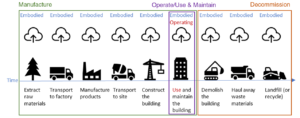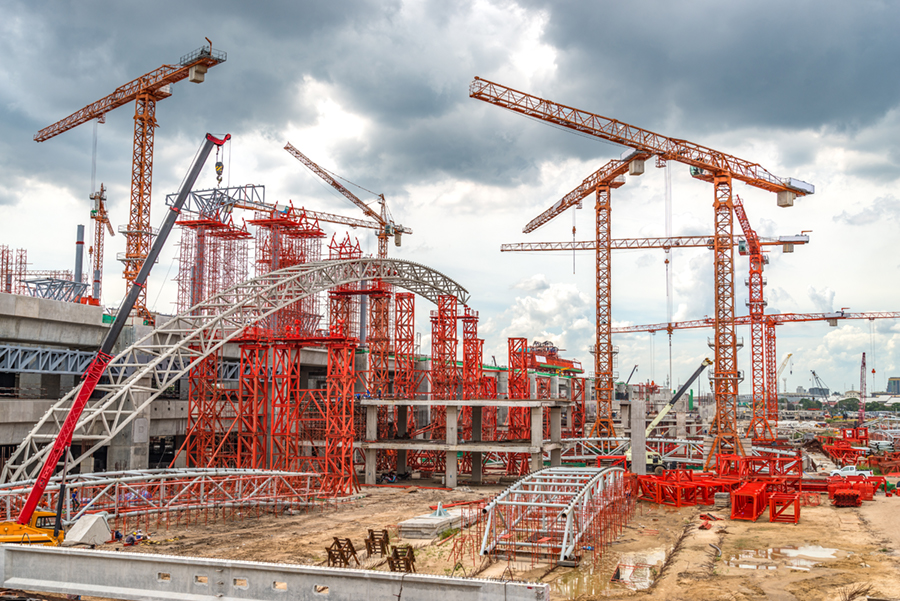Buildings are becoming increasingly energy efficient, with “net-zero” buildings on the horizon. Most efficiency gains to-date have been operationally driven; however, building emissions don’t begin with the first occupants turning on the lights and HVAC system on move-in day. Construction material manufacture, transportation to site and the construction process result in a “carbon debt” before day one of operations, which isn’t considered in most green or net-zero building policy or energy tracking. The carbon associated with these other stages of construction is known as “embodied carbon”.
Embodied carbon refers to the emissions associated with extracting, manufacturing and transporting construction materials; on-site construction; maintenance and refurbishment; and decommissioning (disassembly / demolition and recycling / landfill). These stages are illustrated in Figure 1.

Figure 1: Embodied carbon throughout a building’s life cycle
The past year saw several major embodied carbon-related developments, with acknowledgement of its importance growing and requirements coming for the construction industry.
Summary of Global Best Practices
This year, Forestry Innovation Investment Ltd commissioned Mantle to co-author a report that examined global best practices for addressing embodied carbon in the construction sector. Key findings included:
- Reporting vs performance targets: Although a small handful of jurisdictions require embodied carbon performance below a certain threshold, most leading jurisdictions currently require embodied carbon reporting
- Incentives for reaching aspirational targets: Some leading jurisdictions have embodied carbon aspirational targets, and will provide incentives to projects who meet those targets.
- Future requirements coming: A number of jurisdictions plan to make their “aspirational targets” required in the future.
The review of global leaders also showed that, until now, most action on embodied carbon had been limited to Europe; however, 2017 saw North American governments starting to act to address these emissions. Below is a roundup of leading embodied carbon policies and programs in North America.
California
In October, California became the first jurisdiction in North America to set requirements on the level of embodied carbon emissions contained within certain materials it purchases. The Buy Clean California Act requires that, by 2019, the state set a maximum “acceptable life-cycle global warming potential” for steel rebar, glass, mineral wool insulation and structural steel, based on the industry average for each material. This means that future government spending can only buy the listed material types if their specific manufacturer proves their product is below the industry average threshold for embodied carbon, through an Environmental Product Declaration (EPD).
Ontario
In November, Ontario released its updated long-term infrastructure plan. The province noted it will work towards the use of life cycle assessment (LCA)-based decision making, including for embodied carbon, for major infrastructure projects by mid-2020. LCA-based tools and guidelines are planned to be incorporated into ministries’ business cases for infrastructure investment in 2018.
Government of Canada
In December, the federal government (through the Treasury Board of Canada Secretariat) released its updated Greening Government Strategy. It includes a commitment to reduce the environmental impact of building materials using LCA techniques to minimize embodied carbon in construction and renovation.
Voluntary Systems
The most recent version of LEED (v4) for Building Design and Construction includes a whole building LCA credit which awards up to five points for projects that reduce their embodied carbon and other LCA-based metrics. Additionally, the Canada Green Building Council’s Zero Carbon Building Standard, which was released in May, includes a requirement for reporting embodied carbon.
Embodied Carbon Policy Primer for Ontario
Last week, an embodied carbon policy primer for Ontario was published by the YMCA and Mantle, intended for design teams and policymakers. The primer draws on the lessons learned from a recent YMCA community centre under construction in Toronto which underwent LCA analysis to identify opportunities to reduce embodied emissions. It explores how LCA can be applied in Ontario to minimize life cycle GHG impacts from construction projects. The primer was funded by TAF and combines international best practices and an understanding of Ontario’s specific technical, financial and political context to offer recommended actions that specific stakeholder groups can take to translate lessons learned from LCA research into specific policy and processes.
These developments hint towards embodied carbon and LCA being an even bigger issue in 2018, as governments move from words to action.
To learn more about embodied carbon reporting and reduction, contact Ryan Zizzo at ryan@mantle314.com.

